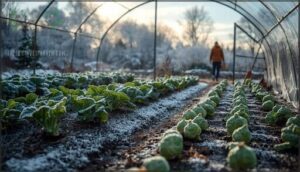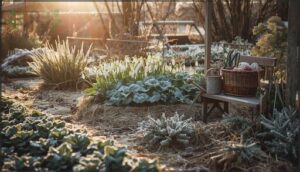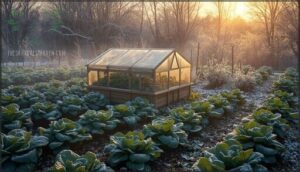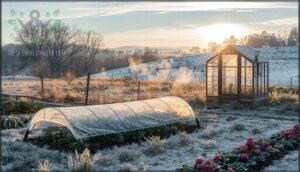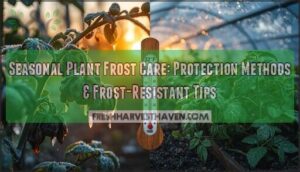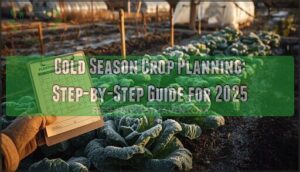This site is supported by our readers. We may earn a commission, at no cost to you, if you purchase through links.
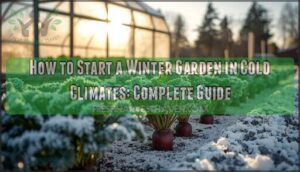 Most gardeners pack away their tools when frost arrives, but winter doesn’t have to mean the end of fresh harvests. In zones 1-5, where temperatures plunge as low as −60°F, certain vegetables actually improve in flavor after freezing—carrots develop extra sweetness, and kale becomes more tender.
Most gardeners pack away their tools when frost arrives, but winter doesn’t have to mean the end of fresh harvests. In zones 1-5, where temperatures plunge as low as −60°F, certain vegetables actually improve in flavor after freezing—carrots develop extra sweetness, and kale becomes more tender.
The key is working with winter’s rhythms rather than fighting them. By understanding your hardiness zone, preparing soil properly in fall, and selecting crops bred to withstand brutal cold, you can pull fresh greens and root vegetables from frozen ground all season.
This guide walks you through each step of establishing a productive winter garden in the coldest climates, from choosing frost-tolerant varieties to building effective protection systems that keep plants thriving when temperatures drop.
Table Of Contents
- Key Takeaways
- Preparing for Winter Gardening
- Starting a Winter Garden in Cold Climates
- Selecting The Right Plants for Winter
- Creating a Winter Garden Plan
- Protecting Your Winter Garden
- Caring for Your Winter Garden
- Growing Vegetables in Winter
- Extending The Winter Gardening Season
- Winter Garden Maintenance and Upkeep
- Bringing Your Winter Garden Indoors
- Frequently Asked Questions (FAQs)
- How do you start a garden in the winter?
- Is gardening in winter a good idea?
- How do I choose a plant for winter gardening in Zone 1?
- How do I choose a plant for winter?
- What are the best winter gardening strategies in Zone 1?
- Which plants can be grown during winter?
- What month do you start a winter garden?
- How cold is too cold for gardening?
- What is a cold frame for winter gardening?
- How to grow vegetables in cold weather?
- Conclusion
Key Takeaways
- Winter gardening in zones 1-5 succeeds when you select cold-hardy crops like kale, spinach, carrots, and Brussels sprouts that tolerate temperatures down to 0°F and actually develop sweeter flavors after frost exposure.
- Starting your winter garden requires precise timing—plant 6-8 weeks before your first fall frost by counting backward from that date and adding 14 buffer days to each crop’s maturity period.
- Physical protection systems like cold frames, row covers, and hoop houses create microclimates that raise temperatures by 4-15°F, extending your growing season by 8-10 weeks without expensive heating equipment.
- Soil preparation in late summer through fall—including pH testing, adding 2-3 inches of compost, and applying mulch after the first frost—creates the foundation that determines whether your winter crops will thrive or fail.
Preparing for Winter Gardening
Before you plant a single seed, you need to understand your local climate and plan the right protection for your garden. Your hardiness zone, frost dates, and choice of season extension method will determine what you can grow and when.
Let’s look at the three essential steps to set yourself up for success.
Know Your Hardiness Zone
Before you plant a single seed, understanding your hardiness zone is the difference between a thriving winter garden and a freezing failure. The USDA Plant Hardiness Zone Map divides North America into 13 zones based on average annual minimum winter temperatures, with cold climates spanning zones 1-5 where winter lows can drop from −60°F to −10°F.
Here’s what you need to know:
- Find your zone by entering your ZIP code on the USDA website to identify which plants can survive your winters
- Account for microclimates since south-facing walls, windbreaks, and urban heat islands can create temperature variations of 5-10°F within the same zone
- Track warming trends as Climate Central reports that 90% of U.S. locations have shifted to warmer zones since 2012, affecting traditional plant choices
- Watch for pest migration since warmer winters have pushed pests northward by approximately 93 miles per decade, requiring adjusted protection strategies
Zone determination guides every decision in your winter gardening journey, from selecting frost-tolerant varieties to timing your plantings. The USDA map’s divisions are based on 10-degree Fahrenheit zones.
Check Your First and Last Frost Dates
Once you know your hardiness zone, frost date tracking becomes your most practical tool for winter planting success. Your first and last frost dates define the frost-free growing season and determine when cold climate gardening can safely begin. In Zone 4, expect your last spring frost between April 24 and May 12, while Zone 5 sees its final frost from April 7-30.
- Online frost calculators that use your ZIP code to pull localized weather data and provide tailored freeze protection timing
- The USDA Plant Hardiness Zone Map which segments regions geographically, helping you understand broader frost patterns
- Your local extension office for historical records that reveal year-to-year variability in frost timing
Choose The Right Season Extension Method
After you’ve tracked your frost dates, matching the right season extension technique to your garden makes all the difference. Cold frames boost soil temperatures by 5–10°F and can stretch your leafy greens harvest by up to two months. Row covers add 4–10°F of warmth while letting in sunlight, and doubling them up extends viability in zones 4–5 by three to four weeks. Hoop houses maintain temperatures 5–15°F higher than outside, pushing your growing window 8–10 weeks further. For year-round production, greenhouse heating stabilizes air within 2°F of your target, though fuel costs can hit 25% of expenses in harsh winters.
Choose based on your situation:
- Small-scale protection: Cold frames work perfectly for salad greens and hardening seedlings
- Flexible coverage: Row covers offer movable frost defense across multiple beds
- Walk-in growing space: Hoop houses shelter larger plantings without breaking the budget
- Controlled environments: Heated greenhouses enable true season extension techniques with microclimate systems
Starting a Winter Garden in Cold Climates
Once you’ve got your zone figured out and your season extension methods ready, it’s time to put theory into practice.
The actual steps of starting your winter garden need to happen in a specific order, and each one builds on the last. Here’s how to get your cold-weather crops from seed to harvest.
Timing is Everything
Your winter garden’s success hinges on precise plant scheduling—counting backward from your region’s first frost date using a simple formula. Calculate days to maturity plus 14 extra days as a buffer, then mark your calendar accordingly. For example, a 60-day crop needs planting 74 days before frost hits.
Climate trends show warming winters are extending frost-free periods, giving you more flexibility with winter sowing and season extension techniques. Check frost dates through your ZIP code resources, then plan succession plantings every 2-3 weeks.
This timing strategy, combined with cold stratification for hardy seeds, ensures your winter planning delivers continuous harvests throughout cold climates.
Start Your Seeds Indoors
Success with winter gardening starts well before your seeds touch soil—your indoor seed starting setup determines whether seedlings will be sturdy enough for harsh conditions. Creating ideal germination rates requires understanding temperature zones: most vegetables need soil temperatures between 68°F and 72°F, which heat mats easily provide by raising tray temperatures 10–20°F above ambient conditions.
Your indoor gardening success depends on these essentials:
- Grow lights with 14–16 hour photoperiods prevent weak, stretched stems while supporting 85–95% transplant survival rates
- Soil temperature monitoring ensures lettuce hits 99% germination at 68°F within eight days
- Well-aerated seed starting mix balances moisture retention without waterlogging that inhibits root growth
- Bottom watering technique maintains consistent hydration while preventing damping-off disease
- Cold climate gardening timing means starting seeds indoors 6–8 weeks before outdoor transplanting
Cold-hardy varieties like broccoli tolerate brief 32°F exposure after proper hardening off, while tender crops need protection below 50°F. Your seed selection and germination rate tracking become your roadmap—tomatoes reach 98% germination at ideal temperatures, but that success translates outdoors only with methodical preparation.
Prepare Your Soil and Garden Beds
Before your seedlings ever step outside, your winter garden’s foundation demands attention. Begin with soil testing to confirm pH levels between 6.0 and 7.0—this range ensures cold-hardy crops access nutrients even when soil temperatures hover near freezing. Loosen soil to 6–8 inches depth for improved winter aeration and drainage, then integrate 2–3 inches of aged compost or manure. This compost integration increases soil organic carbon by roughly 0.9 metric tons per hectare annually while boosting spring nitrogen availability by 18–24%.
Your soil preparation creates these advantages:
- Raised garden bedding thaws 20% faster in spring due to enhanced drainage
- Proper mulch strategies using 4–6 inches of straw buffer nighttime temperatures 2–5°C warmer than bare ground
- Cover crops like winter rye reduce nutrient leaching by up to 69% in unused sections
Apply organic mulch after your first light frost to stabilize soil temperature fluctuations and suppress weeds throughout cold climates. These soil amendments protect your investment while setting the stage for reliable winter gardening success.
Transplant Your Seedlings
Once your beds are ready, it’s time to get those seedlings into the ground. Begin hardening off 7–14 days before transplant timing by gradually exposing plants to outdoor conditions—this process can boost survival rates by 20% in cold climates.
Transplant when soil temperatures consistently reach 50–55°F and daytime air stays above 40°F, usually 6–8 weeks before your first fall frost. Handle seedlings gently to minimize root development disruption, space according to mature size, and apply 4–6 inches of mulch for frost protection after planting.
Selecting The Right Plants for Winter
Choosing the right plants makes all the difference when temperatures drop and daylight fades. Your hardiness zone dictates which cold-hardy crops will deliver consistent harvests through winter. Focus on frost-tolerant varieties that actually improve after exposure to freezing conditions, and you’ll enjoy fresh produce when neighbors have given up.
- Root vegetables like carrots survive freezes to 18°F, while parsnips sweeten dramatically after frost and can overwinter in soil under mulch
- Leafy greens including spinach tolerate 0°F, with savoy varieties outperforming flat-leaf types for winter interest plants
- Brassicas such as Brussels sprouts and kale variety Winterbor endure 0–5°F, providing reliable cold hardy crops throughout the season
- Hardy herbs like thyme and Russian tarragon maintain leaf integrity below 20°F when selecting cold-hardy plants for microclimate factors in your garden
Creating a Winter Garden Plan
A winter garden isn’t just about surviving the cold—it’s about creating a landscape that looks intentional and beautiful even when most plants are dormant. Your plan should focus on structure, placement, and visual interest that holds up against snow and bare branches.
Here’s what you need to keep in mind as you sketch out your winter garden design.
Consider Structure and Form
Your winter garden’s backbone depends on structural elements that stay visible when herbaceous plants die back. Evergreens like boxwood, holly, and spruce should make up at least 30% of your border plantings—they retain over 80% of their foliage year-round, providing wind protection and consistent form. Ornamental grasses such as feather reed grass and switchgrass maintain their upright shape for 90–120 days after frost, creating movement and texture against snow.
Garden frameworks benefit from hardscape features like stone walls, raised beds, and trellises that define spaces while resisting frost heave. Structural materials matter too—aluminum with thermal insulation or reinforced wood creates durable cold frames and bracing.
Layer your plantings vertically from groundcovers to tall trees, boosting windbreak efficiency by up to 60%. Form variation adds depth: cluster evergreens in groups of three to five, incorporate woody perennials with colored stems like red-twig dogwood, and use south-facing walls to capture solar heat. These microclimates and winter landscaping choices transform your garden into a resilient, cold-hardy landscape.
Emphasize Plant Placement
Where you plant can matter more than what you plant when temperatures drop. South-facing garden beds receive 40% more winter sunlight than north-facing ones, giving your cold-hardy plants the photosynthetic boost they need. Strategic placement transforms average spaces into thriving microclimates—place beds within 10 feet of heated buildings and you’ll maintain soil temperatures 3–6°F higher through lateral heat transfer.
Your windbreak strategies and thermal mass elements work together to protect vulnerable crops:
- Position taller plants and trellises to the north and west to reduce wind exposure by up to 35%, shielding shorter winter vegetables from harsh gusts
- Arrange frost-hardy varieties in outermost rows to buffer delicate crops, decreasing cold damage by 12–18%
- Place thermal mass elements like stone walls or water containers within 2 feet of sensitive plants to maintain local temperatures up to 3°F warmer
Avoid frost pockets in low-lying areas where cold air settles—these depressions can drop temperatures 12°F below your general garden average. Microclimate optimization through thoughtful placement boosts plant survival rates by 15% or more.
Define Garden Spaces With Hedging
Beyond strategic plant placement, hedging functions as both an architectural element and a protective shield in cold-climate gardens. Evergreen varieties like Thuja occidentalis and Ilex aquifolium maintain dense foliage through winter, creating permanent garden screening while reducing wind speed by up to 50%. This microclimate creation protects vulnerable plants from desiccating gusts and stabilizes temperatures by approximately 5°C near ground level.
Your hedge planting choices shape how you experience winter structure in your garden:
| Hedge Type | Primary Function | Cold-Hardy Advantage |
|---|---|---|
| Formal evergreens (boxwood, yew) | Define garden borders with year-round density | Retain height to 10 feet, providing continuous screening |
| Informal mixed hedges | Support biodiversity while blocking wind | Increase pollinator habitat by 80% compared to single-species plantings |
| Low-growing borders (lavender, dwarf boxwood) | Create internal space divisions | Reach 18–24 inches in zones H5+, maintaining compact form |
Proper evergreen maintenance during establishment—weekly watering at 1 inch and 2–4 inch mulch layers—ensures your windbreaks develop the density needed for maximum protection. Space arborvitae cultivars at least 6 feet apart to prevent root competition while achieving ideal coverage within 5–15 years.
Consider Garden Furnishings
Once your hedges define garden boundaries, furnishings transform these protected zones into usable spaces throughout winter. Select materials that withstand freezing cycles—teak wood naturally resists rot, while powder-coated steel maintains structural integrity under snow loads without requiring storage. Aluminum-framed pieces offer lightweight portability if you need to reposition seating as sun angles shift, and synthetic wicker won’t crack at subzero temperatures.
Your winter garden furnishings choices extend both function and seasonal appeal:
- Weather-resistant benches optimize space utilization in hoop houses or near cold frames, providing 75-85% efficiency when arranging potted overwintering plants
- Outdoor heaters like infrared units or fire pits create microclimates for evening gardening tasks, warming zones by approximately 10°F
- Weatherproof garden lighting with IP ratings ensures safe navigation to your greenhouse while accent lights highlight evergreen structure against snow
- Durable winter decor such as frost-proof containers protects root systems on benches while adding visual interest when growing vegetables under row covers
Protecting Your Winter Garden
Once you’ve laid out your winter garden design, keeping those plants alive through the toughest months requires deliberate action. Frost protection starts with physical barriers like cold frames, which trap solar heat and raise temperatures by 4–8°C near your plants. Row covers work similarly, creating a warm pocket of air while letting sunlight reach your crops.
For soil insulation, apply 2 to 4 inches of straw or pine needles after the first frost—this mulch layer cuts frost penetration by up to 40% and prevents damaging freeze-thaw cycles that heave roots from the ground. Wind barriers make a surprising difference too. A simple burlap screen or evergreen hedge slows wind speed by 75%, protecting plants from moisture loss and cold stress.
Don’t overlook snow management either. That fluffy white layer insulates roots naturally, keeping soil temperatures stable even when air temps plummet. With these strategies in place, your winter plant care becomes straightforward and your garden stays productive.
Caring for Your Winter Garden
Once your winter garden is established, the real work begins—keeping your plants healthy through the coldest months. Winter gardening isn’t a set-it-and-forget-it process, so you’ll need to stay on top of watering, feeding, pest control, and harvesting.
Here’s what you need to know to keep your garden thriving until spring arrives.
What to Expect During The Cold Months
Winter gardening in cold climates means accepting that your plants will face some of nature’s harshest conditions, but knowing what lies ahead keeps you prepared. Cold climate gardening success depends on understanding how winter weather affects your crops and garden structure.
Plant dormancy is your garden’s primary survival strategy. Cold hardy plants and winter vegetables basically pause their growth when temperatures drop below 40°F, with growth rates declining by up to 90% compared to summer. This dormancy conserves energy and protects plant tissues from frost damage.
Here’s what you’ll face during the cold months:
- Freeze-thaw cycles – Winter soil expands and contracts repeatedly, potentially heaving plants from their beds and exposing vulnerable roots
- Cold snap risks – Sudden temperature drops below 20°F can cause winterkill even in protected crops without adequate frost protection
- Microclimate effects – Structures and snow cover create temperature variations of 5–10°F across different garden areas
- Reduced pest pressure – Extreme cold naturally suppresses many pest populations by 30–80%, though mild winters allow continued activity
Watering and Feeding Your Plants
Your winter garden still needs attention—plants don’t stop requiring water and nutrients just because temperatures drop. Check soil moisture weekly using a trowel or moisture meter several inches down, then water deeply at mid-day when temperatures stay above 40°F. This timing allows proper nutrient uptake before nightfall and reduces frost damage risk.
For fertilizing, apply organic amendments or compost monthly to support slow nutrient release, since cold soils limit availability. Focus watering practices at plant bases, never on foliage, and disconnect irrigation systems immediately after to prevent freeze damage.
Monitoring for Pests and Diseases
Vigilance becomes your most effective tool when protecting winter crops from hidden threats. Cold temperatures don’t eliminate pest and disease problems—they simply shift which invaders you’ll face and where they’ll hide.
Follow these four essential monitoring practices:
- Conduct weekly winter scouting using sticky traps and leaf inspections to catch aphid populations early, since greenhouse infestations can affect more than 30 species of winter crops at 70% humidity levels.
- Deploy biological methods like predatory beetles and parasitoid wasps before pest populations explode, increasing control success rates by 60% compared to reactive treatments.
- Track climate monitoring data including humidity and temperature fluctuations that trigger fungal outbreaks like powdery mildew, especially in protected growing spaces.
- Inspect mulched areas and row covers for slugs and fungus gnats, which thrive in moist winter conditions and complete reproduction cycles in just 17 days.
Effective pest control and disease management during winter relies on catching problems before they spread. Managing winter garden pests through consistent observation reduces major outbreaks by 45% while supporting weed control efforts and overall plant health.
Harvesting Your Winter Crops
Successful crop yield management hinges on understanding winter harvest timing and cold-hardy plants’ unique needs. Harvest root vegetables like carrots, beets, and parsnips between 10:00 AM and 3:00 PM when air temperatures climb above freezing—this window prevents tissue damage and maintains quality.
Cold storage techniques begin in the field: leave hardy crops like Brussels sprouts and kale under frost protection methods such as row covers until you’re ready to harvest, as they’ll continue sweetening with each freeze.
Your winter vegetable garden benefits from these timing strategies:
- Brussels sprouts left on stalks store up to six weeks at 32°F with high humidity
- Root crops retain 85-90% of vitamin C when properly stored at 33°F for four months
- Twice-weekly harvesting prevents freeze-thaw cycles that degrade quality
Post-harvest handling matters—use sharp blades to reduce tissue damage by 20%, and immediately re-cover protected beds. Winter gardening techniques that protect plants from frost extend your harvest window by up to 90 days beyond standard field seasons.
Growing Vegetables in Winter
Growing vegetables through winter might sound tricky, but with the right approach, you can keep fresh greens on your table even when snow’s on the ground. Success comes down to timing your plantings correctly and giving your crops the protection they need from harsh weather.
Here’s how to make winter vegetable gardening work in your cold climate.
Get Ready in Summer
Summer soil prep lays the groundwork for thriving winter crops well before the first frost arrives. Test your soil in early summer to verify pH levels sit between 6.0 and 7.0, giving you enough time to adjust with amendments. By mid-summer, start planning your garden calendar—browse seed catalogs for cold-hardy varieties suited to your hardiness zone, and build new beds if needed.
Incorporate compost or aged manure by late August, allowing organic matter to integrate fully. This preparing for winter gardening approach includes weather forecasting to time crop selection wisely and establishing frost protection strategies now, ensuring your winter vegetables have the rich foundation they’ll need when temperatures drop.
1Start Your Seeds
Starting seeds indoors 8-12 weeks before your first frost gives winter crops a head start they desperately need. Use a quality seed starting mix with good drainage—equal parts compost and vermiculite provides excellent aeration and moisture retention for ideal germination. Position trays under grow lights for 14-16 hours daily, maintaining soil temperatures between 65-70°F with heat mats to boost germination rates above 85%.
- Select cold-hardy varieties suited to your hardiness zone for reliable winter performance
- Practice succession planting every 2-3 weeks to guarantee continuous harvests throughout cold months
- Begin seedling hardening two weeks before transplanting to toughen plants against outdoor conditions
Monitor moisture levels carefully—soil should stay evenly moist but never waterlogged, as excess dampness invites damping-off disease. Once true leaves appear, feed seedlings diluted fertilizer to support vigorous growth.
3Prepare Your Covers
Proper covers act like armor for your winter crops, shielding them from harsh temperatures and wind damage. Clear plastic row covers deliver 8-10°F of frost protection, while heavyweight fabrics like Agribon AG-50 provide 4-6°F of insulation—choose based on your zone’s severity. Cold frames trap solar heat effectively, and hoop tunnel installations with fiberglass rods create stable microclimates. Secure all cover materials with rocks every 2 feet to prevent wind displacement, and plan ventilation access for sunny days when internal temperatures spike unexpectedly.
| Cover Type | Temperature Protection | Best Use |
|---|---|---|
| Clear plastic row covers | 8-10°F | Extreme cold zones, direct frost protection |
| Agribon AG-50 fabric | 4-6°F | Moderate climates, breathable insulation |
| Cold frames | Up to 24°F survival | Root crops, leafy greens, season extension |
| Double-layer systems | 10-15°F combined | Sub-freezing conditions, thermal mass with windbreaks |
4Plant Your Crops
Once your covers are ready, you’ll plant your selected crops at the right depth and spacing to boost winter survival. Seed starting techniques differ for winter—plant brassicas like broccoli and cabbage 0.25 to 0.5 inches deep, while carrots need a similar depth but 1–3 inches between plants. The winter sowing method allows seeds to self-stratify outdoors, though transplanting hardened seedlings gives you 30–40% better survival in subfreezing soil.
For successful cold-hardy plants and vegetable gardening in winter, follow these guidelines:
- Space with precision: Proper plant spacing prevents moisture buildup—allow 18–24 inches between broccoli plants and 12 inches for head lettuce.
- Stagger your plantings: Succession sowing every 14 days extends harvests, especially for arugula and spinach.
- Pair crops strategically: Crop selection matters—plant brassicas near chamomile and dill to repel pests naturally.
- Prepare soil first: Winter gardening demands loosened soil 6–8 inches deep with 2–3 inches of compost for drainage.
Frost protection begins with soil preparation—enriched beds retain heat better than compacted ground.
Extending The Winter Gardening Season
When cold weather pushes the limits of what you can grow, a few simple tools can buy you precious extra weeks—or even months—of productive gardening. Row covers, greenhouses, and smart preparation techniques help you stretch the season on both ends.
Let’s look at how each method keeps your plants thriving when frost threatens.
Using Row Covers and Freeze Protection
When temperatures plummet, row covers become your frontline defense against freeze damage. These protective materials—usually made from spunbonded polyester or polypropylene—offer varying levels of frost protection based on their weight. Lightweight covers allow 90-95% light transmission while protecting down to about 28°F, making them ideal for cold-hardy plants like salad greens. Mediumweight options provide 4-6°F of protection, while heavyweight materials shield crops down to 20°F with up to 8°F of temperature buffering.
You’ll find that proper installation matters just as much as material selection. Secure edges with sandbags or soil anchoring to prevent heat loss and wind displacement, especially since covers lose effectiveness above 10 mph winds. Monitor conditions regularly—row covers can raise daytime temperatures by 10°F or more, requiring ventilation to prevent overheating.
These winter gardening techniques work exceptionally well in cold frame gardening setups, extending your harvest well beyond typical frost dates while supporting healthy winter crop selection.
Creating a Microclimate With Greenhouses
While row covers offer portable protection, a greenhouse transforms your winter gardening into a year-round operation. Greenhouses create stable microclimates that can maintain temperatures up to 30°F warmer than outside conditions, even without supplemental heating.
Choose double-walled polycarbonate panels for insulation methods that cut heat loss by 60% compared to single-layer glass. Position your greenhouse design facing south to capture maximum winter sunlight, and incorporate thermal mass like water barrels or stone to stabilize nighttime temperatures.
Climate monitoring with sensors helps you track temperature and humidity within 0.5°C precision, preventing the overheating that damages cold frames during sunny winter days. This microclimate control facilitates true winter cropping of vegetables that wouldn’t survive outdoors.
Preparing for Spring Gardening
Late winter sets the stage for spring’s success. Think of it as your garden’s preparation period—you’re clearing the path for vigorous growth when warmer weather arrives. Test your soil pH levels between 6.2 and 6.8, which creates ideal conditions for most spring crops. Apply compost or other amendments now to correct nutrient deficiencies identified in your test results, giving them time to integrate before planting season. Remove dead plant material and debris from beds, which can reduce spring disease rates by up to 70%. Sharpen and clean your tools during this downtime to increase spring planting efficiency by 10-15%.
Plan your crop rotation strategy and planting schedule around your zone’s last frost date—usually May 1-16 for Zone 3 gardens. Start frost-tolerant vegetables like peas and cabbage indoors, giving you a head start on harvest.
- Soil preparation combined with garden planning now translates to healthier plants and higher yields during spring planting season, while proper tool maintenance and frost protection strategies keep you ready when the planting season arrives.
Overwintering Plants for an Early Start
Smart overwintering is your ticket to a two-week jump on spring. When you protect hardy plants through winter’s cold and allow proper plant dormancy, you’re setting up earlier harvests and stronger growth. Overwintered spinach yields marketable crops 40% earlier than spring-planted varieties, while properly vernalized perennials bloom 2-4 weeks ahead of schedule. Cold frame gardening maintains soil temperatures 9°F warmer than outside air, creating perfect conditions for winter sowing and seed stratification. These techniques work with cold-hardy plants’ natural rhythms rather than against them.
Your overwintering strategy should include:
- Mulching garlic beds with 6 inches of straw for 80% bulb survival and 18% better spring emergence
- Storing tender perennials at 45-60°F in stable environments to prevent desiccation during dormancy
- Hardening off seedlings gradually over one week, reducing transplant mortality by 24%
- Using frost protection like cold frames for root crops, which maintain yields through subzero conditions
- Starting winter sowing in January through March for zones 3-9, requiring no greenhouse or special equipment
Winter Garden Maintenance and Upkeep
Winter isn’t just a time to let your garden sleep—it’s when thoughtful upkeep keeps things thriving and sets the stage for spring success. A few strategic tasks during the cold months can make a real difference in plant health and garden appearance. Here’s what you should focus on to maintain your winter garden effectively.
Prune for Plant Health
Winter invites you to shape your garden’s future while your plants rest. Dormant pruning during cold months minimizes stress because trees and shrubs aren’t actively growing—they’re conserving energy below ground.
Start by removing dead, diseased, or crossing branches that compete for nutrients and sunlight. Clean cuts made between November and February reduce infection risks by 70–80% since most pathogens stay inactive below 50°F. Sharp, sterilized tools prevent tissue tearing and improve wound closure by 25%, protecting against frost damage to exposed surfaces.
Late winter pruning—roughly 4–6 weeks before spring thaw—works best for plant dormancy care. You’ll see notable results: prune dormant trees properly, and nutrient flow to healthy buds increases by 25%, boosting spring vigor. Opening crowded canopies improves airflow and light penetration by 15–20%, directly supporting plant hardiness.
| Pruning Techniques | Timing | Key Benefit |
|---|---|---|
| Remove dead/diseased wood | November–February | 70–80% fewer infections |
| Prune trees at branch collar | Late winter (above 32°F) | Faster wound healing |
| Thin crowded centers | 4–6 weeks before thaw | 15–20% better photosynthesis |
| Cut crossing branches first | Mid-December–late February | 60% fewer mechanical injuries |
| Angle cuts 45° above buds | During full dormancy | Ideal drainage, outward growth |
Schedule cuts on days above freezing for best frost protection.
Rely on Containers
Containers transform cold-climate winter gardening into a flexible, manageable endeavor. You can shift winter planters toward sunlight, tuck them against walls for frost protection, or relocate them indoors when temperatures plummet—advantages ground-level beds simply can’t match.
Success hinges on strategic container insulation and microclimate creation. Choose pots at least 14 inches in diameter; larger volumes retain soil temperature more effectively and boost survival rates by 20–30% in subfreezing conditions. Non-porous materials like fiberglass or heavy plastic prevent cracking and reduce moisture loss by 15% compared to unglazed clay.
Protect cold-hardy plants with these proven techniques:
- Group containers together to create microclimates where central pots experience 2–4°F warmer root temperatures than isolated edges
- Apply 2–4 inches of mulch to container surfaces, increasing root zone insulation by up to 40% during winter months
- Raise pots on bricks or pot feet to prevent direct ground contact and reduce root freezing risks
- Wrap exteriors in bubble wrap or burlap during extreme cold, cutting freeze damage by up to 30%
- Select plants rated two zones colder than your hardiness zone to account for above-ground root exposure—up to 20°F colder than in-ground conditions
Position containers near south-facing building walls for 3–5°F ambient temperature gains and 10–30% more winter sunlight. Use well-draining potting mixes to prevent root rot, which affects 55% fewer container-grown trees when drainage excels. Check soil moisture weekly; winter desiccation damages plants as severely as overwatering.
For severe climates, move containers into unheated garages or cold frames where root temperatures stay above 25°F, or bury pots in-ground and mulch heavily for 70% greater overwintering success. These strategies deliver 70–85% spring regrowth rates for container-grown perennials and shrubs, proving that smart winter container gardening rivals traditional beds for reliability and visual impact.
Feature Topiaries and Plant Forms
Think of topiaries as year-round garden anchors that truly earn their keep when winter strips away softer plantings. Boxwood, yew, and holly topiaries maintain their sculptural shapes through freezing temperatures, delivering cold-hardy plants that anchor your winter landscaping with reliable evergreen care.
Research shows structured plant forms—spirals, cones, and spheres—increase scenic beauty scores by 27% in winter gardens while providing measurable environmental benefits. Position these ornamental plants as focal points near entryways or along pathways where their geometric precision creates visual order against snow.
Trim topiary designs before the first hard frost in September, then let these evergreen shrubs showcase their architectural strength as garden structures that need minimal maintenance while maximizing winter interest plants throughout the coldest months.
Keep Composting
Your kitchen scraps can become garden gold even when snow blankets your yard. Composting in winter maintains microbial balance through cold climate strategies, though decomposition slows compared to warmer months. Compost management during winter decomposition requires strategic adjustments to keep organic recycling active:
- Build piles at least one cubic yard to retain core temperatures above 70°F despite freezing conditions
- Cover your compost with tarps or straw mulch to prevent excess moisture from snow while insulating against heat loss
- Maintain 50-60% moisture content and a carbon-to-nitrogen ratio between 25:1 and 35:1 for ideal microbial activity
- Add fresh materials in layers, then cover immediately to preserve internal warmth
These composting methods guarantee finished compost ready for spring planting.
Bringing Your Winter Garden Indoors
When temperatures drop and outdoor work slows down, winter gardening doesn’t have to stop entirely. You can bring plants, herbs, and even your gardening plans indoors to keep the growing season alive in your own home.
Here are a few practical ways to extend your winter garden beyond the cold frame and into your living space.
Grow Herbs Indoors in Pots
Growing herbs indoors transforms your windowsill garden into a fresh flavor station all winter long. Success starts with choosing varieties that adapt well to containers—basil, chives, mint, parsley, sage, and thyme consistently rank as the most reliable indoor herbs based on nursery data from 2024.
Your indoor herb garden depends on these key factors:
- Light exposure: Provide at least 5 hours of direct sunlight or use LED grow lights for 14-16 hours daily to maintain healthy growth rates.
- Proper potting mixes: Select well-draining soilless mixes with perlite added for ideal root aeration and drainage through pot holes.
- Temperature control: Keep soil temperature between 65-70°F during the day and 55-60°F at night for vigorous herb development.
- Smart watering tips: Water only when the top inch feels dry, as overwatering reduces yield by 29% compared to proper moisture management.
- Container size: Use pots at least 6 inches in diameter, which produce 33% more foliage than smaller containers.
Regular harvesting encourages bushier growth while keeping your indoor growing season productive.
Start Seeds Indoors for Slow-Growing Vegetables
Slow-growing vegetables like tomatoes and peppers need an early start indoors to reach maturity before frost returns. Begin sowing seeds indoors 8-10 weeks before your last frost date to extend your growing window.
Heat mats maintain soil temperature between 65-75°F, boosting germination rates up to 75% for brassicas and 85% for beets. Provide indoor lighting for 12-14 hours daily using LED grow lights, as light levels limit winter seed starting more than any other factor. Use well-draining potting mixes with perlite for proper root development.
Cold stratification—exposing seeds to 5°C for 6-8 weeks—increases germination by over 40% for cold-hardy plants. Gradually harden seedlings over 7-10 days before transplanting outdoors, ensuring survival rates above 85% and harvests up to 30% higher than direct-sown crops.
Bring in Plants for Winter Interest
Bringing plants indoors extends your winter gardening beyond seed trays and cold frames. Peace lilies and orchids rank among the top indoor choices, thriving at temperatures between 50–90°F with minimal weekly watering. These cold-hardy plants transform windowsills into living displays while improving air quality—species like Boston fern and bamboo palm remove measurable toxins, including formaldehyde and benzene, from your home.
Start moving outdoor plants indoors when temperatures consistently reach 50°F. Clean and inspect them thoroughly, as up to 90% of indoor pest problems originate during this transition. Here’s what adds genuine winter interest:
- Evergreen shrubs like boxwood provide year-round structure and reliable color.
- Seasonal blooms from kalanchoe and Christmas cacti respond beautifully to shorter winter days.
- Indoor greens including bromeliads thrive with 60% humidity and indirect light.
- Winter planters featuring ornamental grass plumes create natural texture indoors.
Properly overwintered plants show 20–30% higher spring flowering rates. Frost protection starts now—group plants together to raise local humidity and position them near windows but away from drafts for 35% better survival rates.
Create a Winter Garden Journal
While bringing plants indoors brightens your space, tracking their progress in a winter garden journal builds knowledge you can use season after season. Think of your journal as a conversation with your future self—one that answers questions about what worked, what didn’t, and why.
Start with journal templates that capture essential winter gardening data. About 67% of experienced gardeners use structured formats to record planting dates and weather events, making garden tracking straightforward and consistent. Your entries should include these fundamentals:
| Record Type | Specific Details |
|---|---|
| Frost Events | First and last frost dates, unexpected freezes |
| Plant Performance | Survival rates, growth patterns, harvest yields |
| Weather Patterns | Daily temperatures, snow cover, rainfall amounts |
| Soil Amendments | Compost additions, fertilizer applications, pH changes |
| Pest Observations | Winter-active insects, disease outbreaks, treatment results |
Year-to-year climate analysis helps 92% of journalers improve their winter planning accuracy. You’ll spot patterns in your cold climate conditions and adjust seed logging schedules accordingly, giving your winter garden a measurable advantage.
Frequently Asked Questions (FAQs)
How do you start a garden in the winter?
You can plant a winter garden by choosing cold-hardy crops like kale, spinach, and carrots, then protecting them with row covers or cold frames that raise temperatures by 4-15°F, creating conditions where vegetables thrive despite freezing weather.
Is gardening in winter a good idea?
Like a marathon runner who thrives in cooler temperatures, winter gardening offers surprising rewards for cold climate gardeners. Cold-hardy plants prove remarkably resilient with proper frost protection methods, while season extension tips using row covers or cold frames can boost survival rates by 50-70%.
You’ll harvest fresh vegetables packed with vitamins A, C, D, and K well into the cold months, reduce grocery bills dramatically, and discover that frost-kissed crops like carrots and Brussels sprouts develop sweeter flavors.
Winter gardening challenges pale against the benefits: extended harvests, garden resilience strategies that prepare you for spring, and the satisfaction of fresh homegrown produce when stores charge premium prices.
How do I choose a plant for winter gardening in Zone 1?
In Zone 1, you’ll work with an exclusive group of cold-hardy plants that tolerate temperatures down to -50°F. Focus on frost-tolerant vegetables like lettuce, arugula, kale, spinach, and carrots—all thrive with cold frames or row covers. For ornamental interest, select winter bloomers and perennials rated for zones 1-3, including bearberry, creeping phlox, red maple, and rock cotoneaster.
Soil preparation matters greatly, so test and amend your beds before planting. Consider microclimate factors like wind protection and sun exposure when selecting cold-hardy plants, as these elements can extend survival rates even in brutal conditions.
How do I choose a plant for winter?
Don’t put all your eggs in one basket—choose cold-hardy plants matched to your hardiness zone and frost tolerance.
Selecting cold-hardy plants like kale, spinach, carrots, and Brussels sprouts ensures winter gardening success, as these frost-tolerant varieties survive low temperatures and develop sweeter flavors after cold exposure.
What are the best winter gardening strategies in Zone 1?
Gardening in Zone 1 demands serious protection strategies. You’ll need heated greenhouses or geothermal systems to combat extreme lows below -50°F, coupled with cold frames and heavy mulching for microclimate management.
Focus on ultra-cold-hardy plants and season extension techniques to achieve any winter crop selection success.
Which plants can be grown during winter?
You won’t believe this, but some vegetables actually prefer the cold—frost makes them sweeter. Hardy crops like kale, spinach, carrots, and Brussels sprouts tolerate temperatures down to 0°F, thriving as cold hardy vegetables with proper protection.
Add frost tolerant greens like arugula and mizuna, overwintering herbs such as thyme and rosemary, and hardy legumes like fava beans for a productive winter garden featuring coldhardy plants through winter sowing techniques.
What month do you start a winter garden?
Most cold-climate gardeners should start their winter garden in late summer—usually between August and early September.
This timing allows cool-season crops to mature before freezing temperatures settle in, giving you hardy vegetables that’ll withstand winter’s chill through proper seed starting and garden planning.
How cold is too cold for gardening?
Most plants face serious cold stress when temperatures drop below 28°F (-2°C), where ice crystals rupture cell walls and cause irreversible damage.
Cold hardy crops like kale tolerate down to 20°F with freeze protection, while root vegetables survive colder temperatures under mulch insulation.
What is a cold frame for winter gardening?
Think of a cold frame as a solar-powered shelter for your winter garden—it’s a bottomless box with a clear lid that traps warmth and blocks frost.
This simple cold frame design creates a microclimate that keeps temperatures 5°F to 10°F warmer inside, protecting cold hardy crops from harsh winds while extending your growing season through season extension techniques.
How to grow vegetables in cold weather?
Success in cold climate gardening starts with selecting hardy varieties like spinach, kale, and carrots that tolerate freezing. Protect crops using row covers and cold frames for frost protection methods while managing soil temperature with mulch. Winter sowing techniques work well in zones 3-
Conclusion
Last February, a Minnesota gardener harvested kale through −30°F temperatures using only row covers and cold frames. Her secret wasn’t expensive equipment—it was understanding how to start a winter garden in cold climates through proper timing and plant selection.
Winter gardening transforms harsh months into productive seasons when you match techniques to your zone’s specific challenges. By preparing soil in fall, choosing hardy varieties, and building simple protection systems, you’ll discover that frozen ground doesn’t mean empty plates.
Your garden can rest or it can deliver fresh harvests—the choice depends on the groundwork you lay today.
- https://www.gardenary.com/blog/winter-garden-survival-tips
- https://www.theprairiehomestead.com/2019/05/how-to-garden-in-a-cold-climate.html
- https://homesteadingfamily.com/gardening-in-winter-cold-weather-growing-methods/
- https://www.quora.com/How-do-I-grow-a-garden-in-the-winter
- https://www.finegardening.com/project-guides/fruits-and-vegetables/cold-frame-gardening?srsltid=AfmBOop0W5KSCMQRhmrEVy7ZOL1VxNo5-Ln2YJWyqk9ZGpJth8MjIkUh

